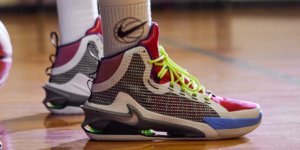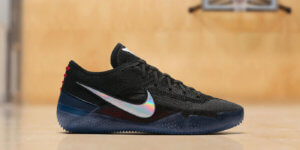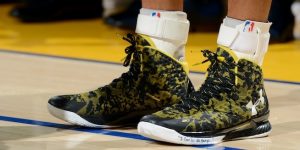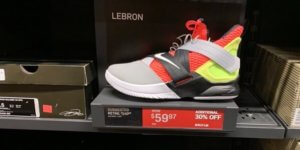Finding the best basketball shoes isn’t just about looking at specs or brand names, it’s about performance on the court. That’s why actually testing shoes matters. Every player moves differently, has a unique play style, and values different things. What works perfectly for one hooper might fall flat for another.
Basketball shoe reviews can often be subjective, especially when based on just one person’s opinion or casual wear. That’s why we take a more complete approach. We gather feedback from multiple expert reviewers who actually test the shoes in real basketball settings, running drills, playing games, and putting each pair through the kind of movements players care about. Their insights are based on real hoop sessions, not just first impressions or off-court comfort.
Let’s get into it.
Best Overall Basketball Shoes
1. Li-Ning Way of Wade All City 13






The Way of Wade All City 13 is one of the most complete basketball shoes we’ve come across this year. From its top-tier traction to the plush cushioning and reliable support, it delivers in every major performance category.
Traction is a major strength. Multiple testers mentioned they “didn’t have to wipe once,” and even on dusty courts, the bite remained consistent. One user described the grip as “phenomenal right out of the box,” which reflects what we’ve also seen on hardwood.
The cushioning setup features full-length Boom foam — and it’s the best we’ve felt from Li-Ning to date. It’s soft underfoot but still springy enough for explosive movements. Guards praised the court feel, while bigger players appreciated the impact protection.
Support and lockdown also impressed. The Euro plate adds noticeable torsional stability, and wide-footers commented that the fit feels more accommodating than the previous All City 12.
One area that could be better is breathability — airflow is mostly centered around the tongue.
✅ Pros
- Outstanding traction, even on dusty floors
- Full-length Boom foam cushioning
- Secure fit and excellent support
- Improved comfort for wide-foot players
- True to size fit
❌ Cons
- Limited breathability in upper
- Slightly heavier than average
2. ANTA KAI 1 Speed





The ANTA KAI 1 Speed builds on the success of the original KAI 1 with a lighter, more responsive design. Players praised the shoe’s low-to-the-ground feel and explosive energy return from the nitrogen-infused foam. One reviewer highlighted the push-off power, saying the shoe “propels you in whatever direction you’re moving.”
Traction is another standout feature. Multiple testers said it performed exceptionally well across surfaces, with one noting, “I never slid out once.” The fit is also impressive. Several reviewers with wider feet appreciated the generous toe box, and most found the fit true to size.
The upper blends support and comfort effectively. Materials break in quickly and offer excellent breathability, especially in versions with embroidered uppers. The plush tongue also received several mentions for adding comfort and lockdown.
However, durability is a weak point. The outsole rubber feels softer, and some noted it might wear down quickly outdoors.
Overall, we think this shoe is a great option for players seeking a fast, low-profile ride without sacrificing support.
✅ Pros
- Grippy traction with consistent bite
- Comfortable, generous fit
- Light and responsive cushioning
- Breathable upper materials
- Great support and lockdown
❌ Cons
- Poor outsole tread durability
3. Adidas Harden Volume 9






The Adidas Harden Volume 9 stands out as one of the most versatile basketball shoes of 2025. Right away, the step-in comfort is noticeable—plush but still responsive. The Lightstrike midsole delivers a low-to-the-ground feel without sacrificing impact protection, making it ideal for guards and wings who rely on quick changes of direction.
Traction is a strong point here. On clean courts, the grip is top-tier, and even on slightly dusty floors, a quick wipe keeps things solid. The materials feel more premium than previous Harden models, especially the breathable upper that adds containment without stiffness.
Some players have mentioned the fit runs a bit narrow at first, but it breaks in nicely after a few runs. We noticed that once broken in, lockdown and lateral support really shine—great for hard stops and step-backs.
The design leans bold and futuristic, which might not be for everyone, but performance-wise, this is easily among the best Harden shoes to date. Whether you play indoors or outdoors occasionally, the durable outsole holds up surprisingly well.
Overall, the Harden Vol. 9 offers a great blend of comfort, control, and stability, especially for dynamic players who need reliable traction and support all game long.
✅ Pros
- Excellent traction on clean courts
- Responsive, low-profile cushioning
- Secure lockdown and stability
- Breathable, lightweight upper materials
- Quick break-in period
❌ Cons
- Attracts dust on dirty courts
- Snug fit for wide feet
Best Traction: Adidas D.O.N. Issue 6






If traction is your top priority, the Adidas D.O.N. Issue 6 delivers elite grip that consistently impresses players across the board. Whether it’s a clean hardwood floor or a dusty rec gym, this shoe bites the court hard and doesn’t let go. The outsole pattern provides multidirectional coverage, and we’ve seen players stop on a dime—even during aggressive lateral movements.
Multiple users shared that the grip held up better than expected even without frequent wiping, a rare feat. It’s the kind of traction that gives players the confidence to push their speed and control. One player described it as “some of the best stops” they’ve experienced on a court, while another noted it “gripped even when things got messy.”
It’s not just about stickiness either. The traction works well with the shoe’s lightweight build, giving quicker guards and wings an edge in responsiveness during cuts and fast breaks. The lockdown and containment also complement the grip, keeping movements sharp and secure.
That said, court feel is somewhat muted and the cushioning setup leans more protective than bouncy.
✅ Pros
- Elite multidirectional grip
- Great on dusty courts
- Light and secure feel
- Strong lockdown support
- Excellent stop-and-go control
❌ Cons
- Not a lot of impact protection
Best Cushion: Nike GT Hustle 3





If you’re searching for the ultimate cushioning setup in a basketball shoe, the Nike GT Hustle 3 delivers in a way few others can. We felt it immediately—plush comfort underfoot, bounce in every step, and a surprising smoothness through transitions. The React foam midsole and ZoomX insole offer soft impact absorption, while the double-stacked Zoom Air in the forefoot gives serious pop when pushing off.
We noticed players who logged a lot of minutes really appreciated how fresh their legs felt late in games. One user said the setup was “insanely comfortable” and perfect for protecting their knees after back-to-back sessions. Another mentioned it felt like a “running shoe built for hoopers,” with soft landings that didn’t sacrifice energy return.
Traction didn’t disappoint either. On clean courts, the grip was top-tier, and even on dustier floors, a quick wipe kept things under control. Materials are breathable and light, which helped keep our feet cool, though a few players noted the upper may wear faster than expected.
If you’re all about comfort and cushioning, this shoe feels like it was made for you.
✅ Pros
- Soft landings, every time
- Explosive forefoot bounce
- Great for long sessions
- Solid grip on clean courts
- Breathable mesh upper
❌ Cons
- Rides high off the ground
- Upper durability is average
Best Support: Nike Lebron 22






The Nike LeBron 22 is one of the most supportive basketball shoes we’ve worn this season. Built for players who demand serious lockdown, this shoe delivers a rock-solid foundation through every cut, jump, and hard landing. The standout feature is the midfoot saddle—several players commented on how it hugs the foot and eliminates side-to-side movement. During lateral drives, you can really feel how the outsole flange adds confidence with its extra-wide base.
We noticed the heel containment is especially strong. No slippage, even when one user with wide feet pushed the shoe hard on step-backs and spins. Another player said it felt like “being strapped into a performance seat,” with both the upper padding and torsional rigidity working together.
That level of structure comes with added weight, and a few players mentioned the shoe feels bulkier than previous LeBron models. Breathability in the forefoot is also limited due to the layered synthetic materials. But if support is your priority, the LeBron 22 sets the bar.
✅ Pros
- Top-tier lateral stability
- Supportive midfoot saddle
- Secure heel lockdown
- Responsive and bouncy cushioning
- Great for wide feet
❌ Cons
- Increased weight
- Poor forefoot ventilation
Best Outdoor Shoe: Li-Ning Wade Ice Blood 2





If you’re hunting for a hoop shoe that can truly take a beating outdoors, the Li-Ning Wade Ice Blood 2 should be on your radar. The outsole uses a dense, ultra-durable rubber compound that handles rough asphalt and blacktops like a champ. After multiple outdoor runs, the traction held up impressively well — no peeling, no smoothing out, just consistent grip on every stop.
The cushioning setup blends 75% Boom foam with 25% Cloud Plus, and the result is a low-to-the-ground ride that still feels springy. Quick guards will appreciate how snappy the shoe feels underfoot, especially during fast cuts and changes of pace. It’s also shockingly lightweight, which adds to the overall agile feel.
However, there are some drawbacks. The fit is very narrow, so players with wide feet might need to size up or look elsewhere. And while the materials perform fine, they don’t feel premium — just functional.
We’ve seen how well it holds up outside, and it’s easily one of the best options for hoopers grinding on outdoor courts.
✅ Pros
- Great for outdoor use
- Lightweight feel
- Snappy, low-profile cushion
- Good lockdown and support
- Solid traction performance
❌ Cons
- Cheap-feeling materials
- Very narrow fit
Best Budget Shoe: Nike Giannis Immobility






The Nike Giannis Immortality 4 retails at $99, but we’ve seen it go on sale frequently for around $60—which is incredible value for what it delivers on-court.
Right away, we noticed how grippy the traction was. Whether we were playing on clean hardwood or slightly dusty courts, the outsole consistently bit hard. Outdoor performance held up too—after several intense runs on asphalt, the rubber barely showed signs of wear. This isn’t always the case at this price point.
Fit was snug at first, especially around the midfoot and toe box. But after a couple sessions, the materials broke in nicely. We appreciated the support—there’s solid containment laterally, and the updated upper wraps the foot well without feeling restrictive. It definitely felt more structured than earlier models in the Giannis line.
Cushioning is responsive and low to the ground. It doesn’t offer a lot of impact protection, but if you like a fast, agile ride, this setup works well. For players who stay on their toes and value court feel, this shoe checks a lot of boxes.
At around $60 on sale, the Immortality 4 is the best-performing budget shoe we’ve played in this year.
✅ Pros
- Grippy traction on all courts
- Tough outdoor rubber outsole
- Stable and supportive fit
- Great value
❌ Cons
- Minimal impact protection
- Some break-in required
Best High Top: Nike Lebron NXXT Genisus






The Nike LeBron NXXT Genisus stands out as the top high-top basketball shoe we’ve worn this year. What makes it special is the exceptional support and containment—it wraps the ankle securely, creating a locked-in feel that boosts confidence on hard cuts and lateral movements. Several of us appreciated how the heel counter and midsole structure kept everything stable without compromising mobility. The forefoot Zoom unit delivers a noticeable bounce, especially during explosive drives or when pushing off in transition.
Fit-wise, it runs true to size for most, but a few teammates with wide feet had better results going up half a size. The upper feels stiff initially, but after a few runs, it softens nicely. One of us described the heel as “super snug, but a bit rigid,” while another liked the snug forefoot fit that left no dead space.
While the materials don’t scream premium at first touch, their performance improves with wear. And the traction? Surprisingly solid on both clean and slightly dusty courts.
✅ Pros
- Excellent ankle support
- Bouncy forefoot cushioning
- Snug forefoot lockdown
- Stable and secure fit
- Solid traction consistency
❌ Cons
- Rigid ankle collar
- Break-in period required
Best For Wide Feet: Adidas AE1






The Adidas AE 1 is easily one of the best basketball shoes we’ve seen for wide-foot hoopers this season. The forefoot offers extra space without sacrificing lockdown, which makes a huge difference in comfort over long games. Players with slightly wider feet consistently mentioned feeling secure without experiencing pinching or hot spots. One user even said it “fit like a glove, even with 2E width.”
Cushioning is another highlight—Boost in the heel and Lightstrike in the forefoot create a smooth ride with excellent step-in comfort and solid responsiveness. There’s enough impact protection to satisfy heavier players, and the torsional support from the midfoot plate keeps the shoe stable even on aggressive cuts.
We’ve seen plenty of positive feedback about the AE 1’s traction too. Whether it’s clean or dusty courts, the grip holds up well. The build is durable but does lean heavy, so it’s best for more powerful players who don’t mind a bit of weight in exchange for premium support.
✅ Pros
- Wide-foot friendly fit
- Plush, responsive cushioning
- Excellent lockdown & support
- Strong traction on all courts
- Stable, torsion-resistant base
❌ Cons
- Shoe is heavy
- Slightly warm during long sessions
Best For Guards: Anta Kai 1 Speed





When it comes to fast, shifty guard play, the ANTA KAI 1 Speed delivers a near-perfect blend of traction, support, and responsiveness. We’ve experienced how well this shoe handles hard cuts, quick stops, and explosive changes of direction. The outsole grips confidently across multiple court types—no slipping, even when dust starts to build.
The nitrogen-infused foam provides the right balance of bounce and court feel, especially under the forefoot. It’s responsive and light, ideal for players who rely on quick acceleration and reaction time. We noticed how easy it was to stay low to the ground while still getting that springy energy return.
Fit-wise, this model is accommodating for both narrow and slightly wide feet. The toe box offers generous space, but overall containment remains excellent. Support around the heel and lateral areas felt dialed-in, keeping movements secure without any slippage.
While it’s not the most outdoor-friendly option due to its softer outsole, the KAI 1 Speed truly shines indoors for aggressive guards who need speed and precision.
✅ Pros
- Excellent court grip
- Lightweight and responsive
- Comfortable toe box
- Breathable materials
- Secure lockdown support
❌ Cons
- Outsole wears quickly outdoors
Find More Shoes!
Choosing the right basketball shoe can make a real difference in how you play and feel on the court. If you want to explore more options or dive deeper into the details, check out our full database of expert-tested models at thehoopsgeek.com/shoe-reviews. We break down every shoe by traction, cushioning, fit, support, and more—so you can find the perfect pair for your play style.

Founder of thehoopsgeek.com. A passionate basketball enthusiast and coding geek, Andy combines a love for sports with technology.







